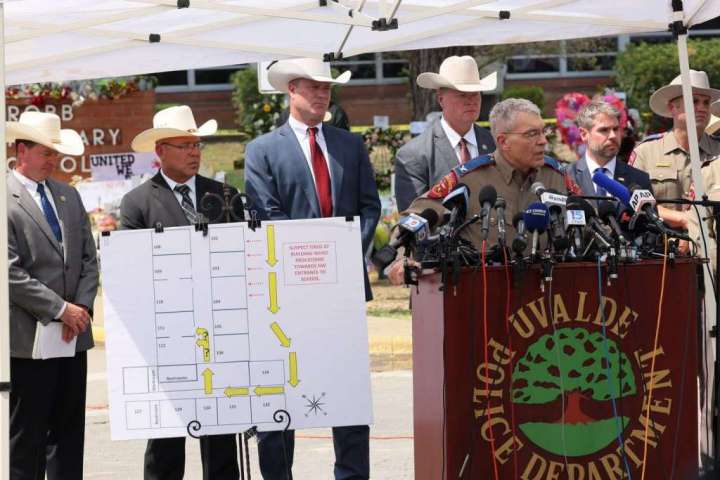Cable-news coverage of mass shootings typically comes with a warning label of sorts: “This is a fluid situation,” said Fox News host Jeanine Pirro said during the network’s early coverage of the Uvalde massacre. “In any kind of shooting like this, or any criminal act of this nature, everything is going to change. The facts are going to change.”
Don’t trust Texas

Never has Pirro been so right.
In a Thursday news conference, Victor Escalon Jr., a regional director with the Texas Department of Public Safety (DPS), announced that the gunman did not encounter a school police officer at Robb Elementary School as he stormed the building before noon Tuesday. “He was not confronted by anybody,” said Escalon.
That was an important detail, considering that it had been reported that there was indeed an armed clash upon his entry.
Nor were those reports based on anonymous “law enforcement officials.” As Mark Berman pointed out in The Post, three separate Texas public-safety officials gave on-the-record accounts of this alleged confrontation, with two of them saying shots were exchanged and a third saying that the two had “engaged” but that no shots were fired.
Follow Erik Wemple‘s opinions
FollowYet more information on this question emerged at a Friday news conference. DPS Director Steven C. McCraw said that the school police officer wasn’t on campus at the time of the assault but responded to a 911 call and drove past the gunman — who was hiding near a vehicle — and toward another person who he thought was the assailant. That was a teacher.
The initial versions, says Texas Tribune editor Sewell Chan, marked a “pretty big departure from fact.” Chan and his colleagues at the nonprofit Tribune have attempted to trace the evolution of the official pronouncements about the assault. “We want to give the benefit of doubt that the authorities are trying to piece together information as responsibly as they can,” says Chan.
Matthew Watkins, the Tribune’s managing editor for news and politics, says that state agencies have a troubled record when it comes to factual integrity. An interagency effort to audit voter rolls in 2019 cratered because of inaccuracies and bad management. And earlier this year, the Tribune and ProPublica documented how the state’s Operation Lone Star, Gov. Greg Abbott’s initiative to stop illegal immigration and drug trafficking at the border, padded the numbers used to tout the project’s success.
The inaccuracies stemming from Uvalde massacre, says Watkins, provide a “sample of what the experience of being a journalist in Texas is right now.”
Other significant discrepancies emerged during the week. Texas officials first said that the gunman rushed into the school after crashing his vehicle near the building; they later said there was a 12-minute period in which he roamed the grounds; and ultimately stated that the period was, in fact, five minutes.
And whereas McCraw on Wednesday said that officials kept the gunman “pinned down” in the classroom where he killed students, Escalon later clarified that no such operation took place. Instead, an hour or so elapsed before a tactical Border Patrol unit burst into the classroom and killed the shooter. Nineteen officers waited inside the school even as children inside the classrooms called 911 pleading for help.
The erroneous early accounts invariably cast official actions in a more flattering light than the corrections. A key moment in the unraveling occurred Wednesday, when the Associated Press reported that onlookers had pressed police outside the school to get more aggressive. The next morning, Lawrence Jones, an “enterprise reporter” on “Fox & Friends” called the AP story “ridiculous.”
“I was on the phone all night talking to furious law enforcement officials,” said Jones. “It is so personal to suggest that they didn’t go into danger.”
With that, Jones opened a display case on the perils of believing everything you hear from the police. Like any profession, police are susceptible to groundless rumors, half-baked reports and a fierce aversion to unfavorable publicity. And at least in this case, they didn’t hesitate to attach their names to the bad information. Jones was forced to concede that he’d given his sources the “benefit of the doubt.”
Does that mean news outlets can’t quote Abbott, McCraw & Co.? No, says Chan: “I don’t want us to be in a situation where an assertion by a public official is taken just like any other assertion. We have a responsibility to at least reflect their accounts and versions of what happened.”
Not to mention a responsibility to make some disclosures along the way. “We do also have to ask ourselves, what’s the context?” says Watkins. “What information do we not know, and what’s the history of things that turned out not to be true? We’ve carried that history into our reporting and how we present the information we’ve been giving to our readers.”
In a Friday afternoon news conference, Abbott was asked whether the inaccurate information that he spread was part of an effort to craft a “favorable narrative.” No, he said; he’d been “misled.”
“When I came out here on this stage and told the public what happened, it was a recitation of what people in that room told me,” said Abbott, referring to a briefing on the tragedy with law enforcement officials and others. “And as everybody has learned, the information that I was given turned out, in part, to be inaccurate, and I’m absolutely livid about that.”
Just like Jones, the governor has a sourcing problem.






